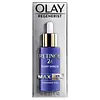What's inside
What's inside
 Key Ingredients
Key Ingredients

 Benefits
Benefits

 Concerns
Concerns

 Ingredients Side-by-side
Ingredients Side-by-side

Water
Skin ConditioningDimethicone
EmollientGlycerin
HumectantRetinol
Skin ConditioningRetinyl Propionate
Skin ConditioningNiacinamide
SmoothingTropaeolum Majus Flower/Leaf/Stem Extract
Skin ConditioningPalmitoyl Pentapeptide-4
Skin ConditioningDimethiconol
EmollientLaureth-4
EmulsifyingPolysorbate 20
EmulsifyingLaureth-7
EmulsifyingDisodium EDTA
Dimethicone Crosspolymer
Emulsion StabilisingPolyacrylamide
Titanium Dioxide
Cosmetic ColorantMica
Cosmetic ColorantC13-14 Isoparaffin
EmollientDMDM Hydantoin
PreservativeIodopropynyl Butylcarbamate
PreservativeWater, Dimethicone, Glycerin, Retinol, Retinyl Propionate, Niacinamide, Tropaeolum Majus Flower/Leaf/Stem Extract, Palmitoyl Pentapeptide-4, Dimethiconol, Laureth-4, Polysorbate 20, Laureth-7, Disodium EDTA, Dimethicone Crosspolymer, Polyacrylamide, Titanium Dioxide, Mica, C13-14 Isoparaffin, DMDM Hydantoin, Iodopropynyl Butylcarbamate
Water
Skin ConditioningDimethicone
EmollientPropanediol
SolventGlycerin
HumectantRetinol
Skin ConditioningCaprylic/Capric Triglyceride
MaskingBakuchiol
AntimicrobialVaccinium Macrocarpon Fruit Extract
AstringentLactobacillus Ferment
Skin ConditioningTocopherol
Antioxidant1,2-Hexanediol
Skin ConditioningHumulus Lupulus Extract
AntimicrobialDimethiconol
EmollientPolyacrylate Crosspolymer-6
Emulsion StabilisingMaltodextrin
AbsorbentHydroxyethyl Acrylate/Sodium Acryloyldimethyl Taurate Copolymer
Emulsion StabilisingPotassium Sorbate
PreservativeSqualane
EmollientSodium Gluconate
Skin ConditioningCaprylhydroxamic Acid
Copernicia Cerifera Cera
EmollientCitric Acid
BufferingPolysorbate 20
EmulsifyingPolysorbate 60
EmulsifyingHelianthus Annuus Seed Oil
EmollientCaprylyl Glycol
EmollientHydroxymethoxyphenyl Decanone
Skin ConditioningDisodium Cocoamphodiacetate
CleansingC13-16 Isoalkane
SolventT-Butyl Alcohol
PerfumingXanthan Gum
EmulsifyingEthyl Ferulate
AntioxidantWater, Dimethicone, Propanediol, Glycerin, Retinol, Caprylic/Capric Triglyceride, Bakuchiol, Vaccinium Macrocarpon Fruit Extract, Lactobacillus Ferment, Tocopherol, 1,2-Hexanediol, Humulus Lupulus Extract, Dimethiconol, Polyacrylate Crosspolymer-6, Maltodextrin, Hydroxyethyl Acrylate/Sodium Acryloyldimethyl Taurate Copolymer, Potassium Sorbate, Squalane, Sodium Gluconate, Caprylhydroxamic Acid, Copernicia Cerifera Cera, Citric Acid, Polysorbate 20, Polysorbate 60, Helianthus Annuus Seed Oil, Caprylyl Glycol, Hydroxymethoxyphenyl Decanone, Disodium Cocoamphodiacetate, C13-16 Isoalkane, T-Butyl Alcohol, Xanthan Gum, Ethyl Ferulate
 Reviews
Reviews

Ingredients Explained
These ingredients are found in both products.
Ingredients higher up in an ingredient list are typically present in a larger amount.
Dimethicone is a type of synthetic silicone created from natural materials such as quartz.
What it does:
Dimethicone comes in different viscosities:
Depending on the viscosity, dimethicone has different properties.
Ingredients lists don't always show which type is used, so we recommend reaching out to the brand if you have questions about the viscosity.
This ingredient is unlikely to cause irritation because it does not get absorbed into skin. However, people with silicone allergies should be careful about using this ingredient.
Note: Dimethicone may contribute to pilling. This is because it is not oil or water soluble, so pilling may occur when layered with products. When mixed with heavy oils in a formula, the outcome is also quite greasy.
Learn more about DimethiconeDimethiconol is a silicone that resembles the popular dimethicone. Like other silicones, it is an emollient. Emollients create a thin film on skin to prevent moisture from escaping.
This ingredient helps to create a silky texture and improve spreadability. Due to its high molecular weight and thickness, it is often combined with cyclopentasiloxane.
Glycerin is already naturally found in your skin. It helps moisturize and protect your skin.
A study from 2016 found glycerin to be more effective as a humectant than AHAs and hyaluronic acid.
As a humectant, it helps the skin stay hydrated by pulling moisture to your skin. The low molecular weight of glycerin allows it to pull moisture into the deeper layers of your skin.
Hydrated skin improves your skin barrier; Your skin barrier helps protect against irritants and bacteria.
Glycerin has also been found to have antimicrobial and antiviral properties. Due to these properties, glycerin is often used in wound and burn treatments.
In cosmetics, glycerin is usually derived from plants such as soybean or palm. However, it can also be sourced from animals, such as tallow or animal fat.
This ingredient is organic, colorless, odorless, and non-toxic.
Glycerin is the name for this ingredient in American English. British English uses Glycerol/Glycerine.
Learn more about GlycerinPolysorbate 20 is made by combining ethoxylation of sorbitan, ethylene oxide, and lauric acid. It is a mild cleansing agent, surfactant, and emulsifier.
As a surfactant, it helps collect dirt and oils for washing. Emulsifiers prevent oils and water from separating.
Polysorbate 20 also adds scent to a product. Since it is made using sorbitol, it has a sweet scent. Sorbitol can also be found in fruits such as apples and peaches.
The lauric acid used to create Polysorbate 20 is often derived from coconuts.
Polysorbate 20 may not be fungal acne safe.
Learn more about Polysorbate 20Retinol is a gold-standard ingredient for anti-aging. It is a form of Vitamin A and belongs to the class of retinoids that also includes tretinoin.
Why is retinol famous?
It has the most scientific studies backing up its skin benefits out of all the non-prescription ingredients.
Retinol is proven to:
This is why retinol is effective at removing wrinkles, fading dark spots, treating acne, and reducing the appearance of pores.
Studies show retinol is less effective when exposed to UV. Be sure to look for appropriate packaging to keep your retinol potent (similar to Vitamin C).
Using retinol or any retinoids will increase sun-sensitivity in the first few months. Though studies show retinoids increase your skin's natural SPF with continuous use, it is best to always wear sunscreen and sun-protection.
We recommend speaking with a medical professional about using this ingredient during pregnancy.
Retinol may cause irritation in some people, so be sure to patch test. Experts recommend 'ramping up' retinol use: start using this ingredient once a week and work up to using it daily.
Read about Tretinoin
Learn more about RetinolWater. It's the most common cosmetic ingredient of all. You'll usually see it at the top of ingredient lists, meaning that it makes up the largest part of the product.
So why is it so popular? Water most often acts as a solvent - this means that it helps dissolve other ingredients into the formulation.
You'll also recognize water as that liquid we all need to stay alive. If you see this, drink a glass of water. Stay hydrated!
Learn more about Water